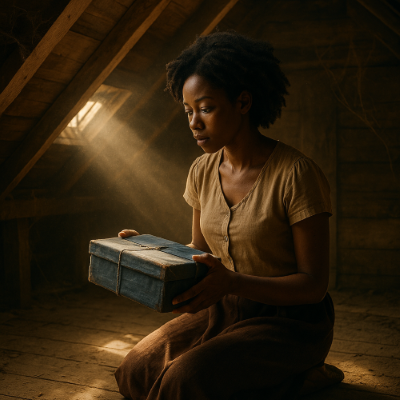The Forgotten Letters
Chapter 1: The Attic Dust
Ama hadn’t planned on returning to Akwatia. Not for the funeral. Not for the house. And certainly not for the memories.
The house creaked with stories — the kind that clung to walls and refused to die, no matter how many years passed. Her grandmother, Maame Efua, had lived here for nearly 80 years, and now the house stood still, as if mourning too.
Ama brushed cobwebs aside as she climbed into the attic. The air was thick, warm, and smelled like old yam leaves and camphor. She wasn’t sure what she was looking for — maybe just a way to feel closer to the woman who had raised her until she was ten.
That’s when she found it: a box wrapped in faded blue cloth, hidden beneath an old sewing machine. Inside were letters. Dozens of them. All sealed. All addressed to her grandmother… and signed in a handwriting Ama didn’t recognize:
“With all my love, Kojo.â€
Chapter 2: The First Letter
Ama sat cross-legged on the attic floor. Her hands trembled as she opened the first envelope.
“My dearest Efua,
I waited by the cocoa tree again today. Your laugh still echoes in my ear. I know your father forbade us from speaking, but I can’t forget you. I won’t. You once told me that real love endures silence — I hope these letters find you one day.â€
Yours always,
Kojoâ€
Ama blinked hard. The ink was smudged in some places — tears? Rain? Her grandmother never spoke of a Kojo. Only of Ama’s grandfather, Nana Kwaku, who died before she was born. She reached for the second letter. And the third.
Kojo wrote every week for over a year. The tone shifted — from hopeful, to desperate, to shattered.
Chapter 3: A Story Never Told
That night, Ama couldn’t sleep. She sat at the dining table with all the letters spread before her like puzzle pieces.
She called her mother in Accra.
“Ma… who’s Kojo?â€
The silence on the other end was deep.
“Where did you hear that name?†her mother finally asked.
“I found letters. In the attic. They’re all addressed to Maame.â€
Her mother sighed. “Ah, Ama. That’s a story she never wanted told.â€
“Tell me.â€
Her mother hesitated. “Kojo was the man your grandmother loved. But she married your grandfather instead. Arranged. Her father threatened to disown her. Kojo left the village. They said he went mad from heartbreak. No one ever heard from him again.â€
Chapter 4: The Unsent Answer
But Kojo had written. Dozens of times.
Had her grandmother received the letters?
Ama looked closer at the envelopes. None of them had stamps. None were opened. Had someone intercepted them? Maybe her great-grandfather? Maybe Maame Efua never knew Kojo wrote at all.
She found one letter different from the rest — an envelope with faded lipstick smudges on the back.
Inside was a response.
“My dearest Kojo,
If only you knew how often I stood near that cocoa tree, hidden behind the cloth of obedience and shame. My father burned your first letter. I thought you'd given up. I never received the rest. I married Kwaku, but I buried my joy.
You were my great what-if. I hope life was kind to you. I hope you forgave me.
Efuaâ€
Ama’s eyes filled. Her grandmother did write back — once.
Chapter 5: The Man in the Photograph
Ama went back to the box. Underneath the last layer of letters was an old, black-and-white photo of a young man in a hand-sewn shirt, holding a notebook.
On the back: “Kojo, 1954. Taken by Efua. The day before everything changed.â€
The next morning, Ama walked to the local library. She asked the clerk — a woman in her seventies — if she remembered anyone named Kojo from the 1950s.
The woman adjusted her glasses. “There was a Kojo Mensah. Brilliant. Wrote poetry. They say he left after his heart was broken. Went to teach in Tamale. Some say he never married.â€
Ama felt a pulse in her chest. She had to know more.
Chapter 6: The Journey North
A week later, Ama boarded a bus to Tamale, clutching the box of letters like a sacred relic. She followed lead after lead — old teachers, elders, librarians.
Finally, at a dusty school near Sagnarigu, she met someone who remembered him.
“Kojo Mensah? Oh yes. Quiet man. Taught English. Always carried a red pen and a green notebook. He lived alone.â€
“Where is he now?†Ama asked, heart pounding.
“He passed in 2002. But he left his books and notes with the school. They’re in the archives.â€
Ama walked to the tiny library behind the school. In a box labeled “K.M.†were yellowing pages of handwritten poems.
In one corner of a torn page was scribbled:
“To E. Always. Even in silence.â€
Chapter 7: The Final Gift
Back in Akwatia, Ama sat beneath the old cocoa tree behind her grandmother’s house. For the first time in her life, she felt she knew her.
Not as “Maame Efua the seamstress,†but as Efua the dreamer, the woman who once kissed a boy in secret, who obeyed out of duty but carried a broken heart for decades.
Ama took the letters — both Kojo’s and Efua’s — and placed them gently into a wooden box. She buried it beneath the cocoa tree.
Not to hide it.
But to root it.
A symbol that even in silence, truth finds its way.
Epilogue
Years later, Ama published a book titled The Forgotten Letters. It sold quietly but steadily. A blend of poetry, fiction, and real history — dedicated “To the ones who loved in silence and never stopped hoping.â€
One reader wrote:
“I wept for Kojo. I wept for Efua. And I thanked God that someone finally told their story.â€
Ama smiled.
Some stories aren’t forgotten.
They’re just waiting to be remembered.


